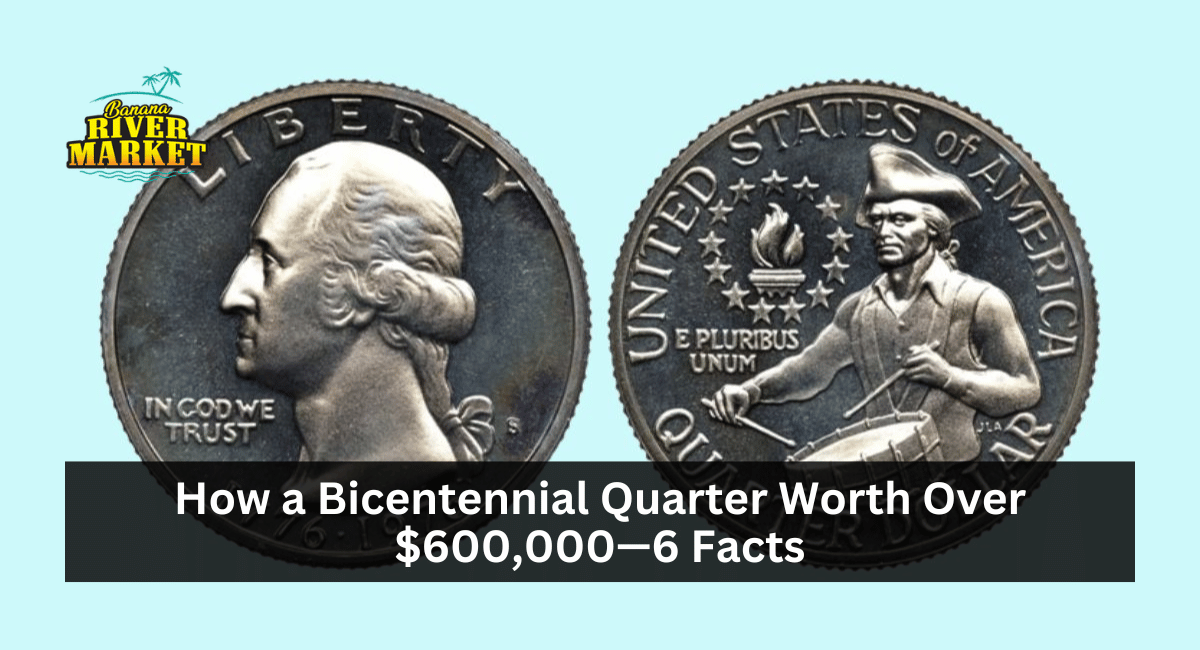The Bicentennial Quarter, minted in 1976 to mark the 200th anniversary of American independence, holds a special place in U.S. coinage.
Featuring a unique design with a colonial drummer and the dual date “1776-1976,” this quarter has become iconic among collectors.
While most Bicentennial Quarters are still in circulation, a rare few have gained extraordinary value, with some selling for over $600,000. Let’s dive into six essential facts about this coin, explaining how and why it became valuable.
1. Two Types of Bicentennial Quarters: Type 1 and Type 2
When the Bicentennial Quarter was minted, the U.S. Mint produced two versions: Type 1 and Type 2. The style of their lettering distinguishes these types:
- Type 1: Features bold, block-style lettering.
- Type 2: Has thinner, refined lettering.
Collectors prize Type 1 quarters more, especially if they’re in excellent condition or feature unique minting errors. Coins well-preserved and graded at high levels can command thousands of dollars.
2. The 1976-S Silver Bicentennial Quarter
Most Bicentennial Quarters are made of copper-nickel, but there’s also a rarer silver version. The 1976-S Bicentennial Quarter, explicitly created for collectors, has a silver-clad composition.
While these silver quarters were sold as part of unique sets, a few made their way into circulation over time.
Silver Bicentennial Quarters are especially valuable for collectors if they’re in pristine condition. Compared to the standard copper-nickel quarters, these silver ones sell for much higher prices, mainly when graded at MS67 or above.
3. The Importance of High-Grade Coins
Grading, which measures a coin’s condition and quality, is critical in determining the Bicentennial Quarter’s value.
Coins with high grades, especially those graded MS67 or above, are scarce and valuable. Minor handling marks or blemishes can lower a coin’s grade, so those that are near-perfect are especially prized.
- Coins graded at MS69 or MS70: Near-flawless examples in these grades have sold for record prices, sometimes surpassing $600,000 at auction.
- Grades below MS67: While still collectible, they generally reach higher values than those in near-mint conditions.
4. Error Coins – Unique and Valuable
In coin collecting, errors are often viewed as unique treasures.
Bicentennial Quarters with minting errors—such as doubled dies, off-center strikes, or missing clad layers—can be highly valuable.
These errors make each coin unique, adding a rarity factor many collectors find irresistible.
- Doubled Die Errors: This error occurs when the die strikes the coin twice, creating a doubling effect on certain parts of the design. Doubled die Bicentennial Quarters are particularly sought-after.
- Off-Center Strikes: Part of the design may be missing when a coin is struck off-center. These coins are visually distinct and, therefore, highly desirable to collectors.
- Missing Clad Layer: A missing clad layer gives the coin an unusual appearance, increasing its rarity and value.
Error Bicentennial Quarters, especially in high-grade condition, are highly collectible and can fetch significant prices, sometimes reaching tens of thousands of dollars.
5. Proof Bicentennial Quarters – The Collector’s Edition
Proof coins are specially minted with polished dies to produce a sharp, mirror-like finish. Proof Bicentennial Quarters, often struck in either silver or copper nickel, are not meant for circulation and are typically reserved for collectors.
- High-Grade Proofs (PR70): Proof Bicentennial Quarters graded at PR70 (perfect grade) are rare and valuable. Their flawless finish and fine details attract serious collectors.
- Unique Appearance: Proof coins’ reflective quality and detail distinguish them from regular quarters, making them a coveted addition to any collection.
Proof Bicentennial Quarters, when graded highly, can sell for thousands of dollars, with perfect specimens being the most valuable.
6. Overview of Bicentennial Quarter Values
As shown in the table below, the Bicentennial Quarter’s value can vary greatly depending on its type, composition, condition, and unique features.
| Type of Bicentennial Quarter | Composition | Condition Grade | Notable Feature | Value Range ($) |
|---|---|---|---|---|
| Type 1 Bicentennial Quarter | Copper-Nickel | MS67 or higher | Block-style Lettering | 1,000 – 50,000 |
| 1976-S Silver Quarter | Silver-Clad | MS67 or higher | Special Collector’s Edition | 5,000 – 100,000 |
| High-Grade MS69-MS70 | Copper-Nickel | MS69 or MS70 | Near-Perfect Condition | 200,000 – 600,000+ |
| Error Bicentennial Quarters | Copper-Nickel | Varies by error | Doubled Dies, Missing Layer | 500 – 50,000 |
| Proof Bicentennial Quarter | Silver or Copper-Nickel | PR70 or higher | Mirror Finish, Detailed Strikes | 1,000 – 10,000 |
Conclusion:
With its commemorative design and historical significance, the Bicentennial Quarter continues to fascinate collectors. While many of these coins are still in regular use, the rare versions—including high-grade, error, silver, and proof quarters—can be worth a small fortune.
Whether you’re a seasoned collector or a curious beginner, knowing what to look for in a Bicentennial Quarter can make a big difference. Keep an eye out for these factors, as you might just come across a hidden treasure in your change!
FAQs
The value of a Bicentennial Quarter depends on factors such as its type, composition (silver or copper-nickel), grade, and any unique features like errors or special finishes.
Not all Bicentennial Quarters are rare. The standard copper-nickel versions still circulate widely. However, high-grade coins, silver-clad editions, proof versions, and error coins are significantly rarer and more valuable.
To get an accurate grade, consider submitting your coin to a professional grading service like PCGS (Professional Coin Grading Service) or NGC (Numismatic Guaranty Corporation).
These services assess the coin’s quality and provide a grade that can impact its value.
Errors such as doubled dies, off-center strikes and missing clad layers make a Bicentennial Quarter more valuable. These errors are relatively rare, giving the coins a uniqueness that collectors highly value.
If you own a valuable Bicentennial Quarter, you can consider selling it at auctions, through numismatic dealers, or online platforms focused on coin collecting. Specialized coin auctions often attract serious collectors willing to pay premium prices
READ MORE: Say Goodbye to the $1 Bill-Here’s How It Will Impact You!

